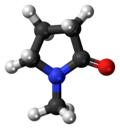| |||
| Names | |||
|---|---|---|---|
| Preferred IUPAC name
1-Methylpyrrolidin-2-one | |||
| Other names
1-Methyl-2-pyrrolidone
N-Methylpyrrolidone N-Methylpyrrolidinone Pharmasolve | |||
| Identifiers | |||
3D model (JSmol)
|
|||
| ChEBI | |||
| ChEMBL | |||
| ChemSpider | |||
| ECHA InfoCard | 100.011.662 | ||
| KEGG | |||
PubChem CID
|
|||
| UNII | |||
CompTox Dashboard (EPA)
|
|||
| |||
| |||
| Properties | |||
| C5H9NO | |||
| Molar mass | 99.133 g·mol−1 | ||
| Density | 1.028 g/cm3 | ||
| Melting point | −24 °C (−11 °F; 249 K) | ||
| Boiling point | 202 to 204 °C (396 to 399 °F; 475 to 477 K) | ||
| Soluble[1] | |||
| Solubility in Ethanol, acetone, diethylether, ethyl acetate, chloroform, benzene | Soluble[1] | ||
| log P | −0.40[2] | ||
| Hazards | |||
| NFPA 704 (fire diamond) | |||
Except where otherwise noted, data are given for materials in their standard state (at 25 °C [77 °F], 100 kPa).
| |||
N-Methyl-2-pyrrolidone (NMP) is an organic compound consisting of a 5-membered lactam. It is a colorless liquid, although impure samples can appear yellow. It is miscible with water and with most common organic solvents. It also belongs to the class of dipolar aprotic solvents such as dimethylformamide and dimethyl sulfoxide. It is used in the petrochemical, polymer and battery industries as a solvent, exploiting its nonvolatility and ability to dissolve diverse materials (including polyvinylidene difluoride, PVDF).[3] The low toxicity is also a reason to use this solvent.
- ^ a b Sigma-Aldrich Co., 1-Methyl-2-pyrrolidinone. Retrieved on 22 March 2022.
- ^ "N-Methylpyrrolidone_msds".
- ^ Harreus, Albrecht Ludwig; Backes, R.; Eichler, J.-O.; Feuerhake, R.; Jäkel, C.; Mahn, U.; Pinkos, R.; Vogelsang"2-Pyrrolidone, R. (2011). Ullmann's Encyclopedia of Industrial Chemistry. Weinheim: Wiley-VCH. doi:10.1002/14356007.a22_457.pub2. ISBN 978-3527306732.
{{cite encyclopedia}}: CS1 maint: numeric names: authors list (link)


